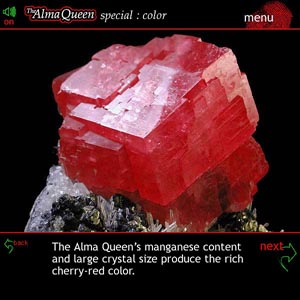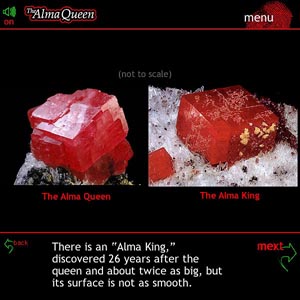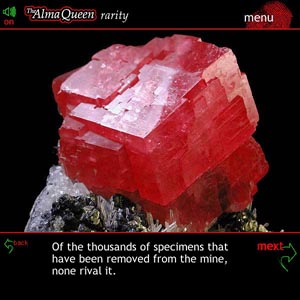 |
 |
 |
 |
 |
|
The Alma Queen
Touch a question to read the answer
- What makes it so special?
- Why is it called the Alma Queen?
- How rare is it?
- How is rhodochrosite used?
|
This specimen is remarkable due to its
- size
- crystalline matrix
- deep red color
- aesthetics
|
These crystals formed under pressure
in a hot, mineral rich water solution between layers of rock underground. |
|
|
|
 |
 |
 |
| [animated] When the solution cooled
and evaporated, the minerals in the solution settled out in orderly patterns
on the walls, forming crystals. |
[animated] The slower the water
cools, the larger the crystals get. |
For the Alma Queen to get this
big, the solution had to cool very slowly. |
|
|
|
 |
 |
 |
| Also, few large crystals remain
attached to the crystalline matrix where they formed; and few matrices are
as perfect as this. |
"Rhodochrosite" means "rose-colored."
Most specimens range from pink to this intense red. |
The Alma Queen's manganese content
and large crystal size produce the rich cherry-red color. |
|
|
|
 |
 |
 |
| These
reasons--large size, aesthetic beauty, and deep color--make the Alma Queen
exceptionally rare and valuable. |
Why is it
called the "Alma Queen"? |
It was
removed in 1996 from the Sweet Home Mine, located in the Alma Mining
District, about 100 miles west of Denver. |
|
|
|
 |
 |
 |
| The mine is
located near others on the eastern slope of a mountain in Colorado's
Mosquito Range. |
The district
was named after a woman named Alma, one of the first residents of the
region. |
It is called
the Queen because it reigns--as the most beautiful of its kind in the
world. |
|
|
|
 |
 |
 |
| There is an
"Alma King," discovered 26 years after the queen and about twice as big,
but its surface is not as smooth. |
[new section]
How rare is it? |
For the Alma
Queen to form, many perfect conditions had to exist. |
|
|
|
 |
 |
 |
| A pocket of
hot, high-pressure, mineral-rich solution had to be trapped between laters
of rock underground. |
The solution
had to cool slowly and evenly. |
The solution
ahd to have the right concentration of elements and acidity to form
rhodochrosite. |
|
|
|
 |
 |
 |
| Chemical and
physical conditions had to remain undisturned for the entire time the
crystal was forming. |
Against all
odds, everything came together 30 million years ado deep under the Rocky
Mountains of Colorado. |
There the
crystals waited until silver miners discovered them at the beginning of
the 20th century. |
|
|
|
 |
 |
 |
| For a time
the mine was closed, but in the last half of the 20th century the mine was
reopened. |
Many more
crystals have been found since then, including the Alma Queen. |
Of the
thousands of specimens that have been removed from the mine, none rival
it. |
|
|
|
 |
 |
 |
| [new section]
How is rhodochrosite used? |
Rhodochrosite
from the Sweet Home Mine is beautiful enough to be a semi-precious
gemstone, but it is too brittle and soft for daily wear. |
If you wore
it in a ring, one good bump against a countertop would be enough to crack
the mineral and ruin it. |
|
|
|
 |
 |
 |
| Rhodochrosite
can be used in artistic jewelry that will not get much wear and tear, and
in ornamental carving. |
Additionally,
mineralogists and collectors value rhodochrosite specimens because of
their rarity and beauty. |
Chemically
rhodochrosite is manganese carbonate. [several following detail screens
are omitted] |
| The above screens are all static output pages. The 360° viewer is a more interactive experience for the user, allowing them to spin the specimen to see it from any angle, or to zoom in and see very close detail. |
 |
|
 |
|
 |
| Users tap the
screen to spin the video image of the Queen. |
|
Tapping one of
the green boxes reveals detail images, which users can tap to dismiss. |
|
Users have the
option to turn off the green boxes so they can spin a clean view of the
specimen. |



































